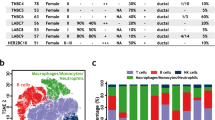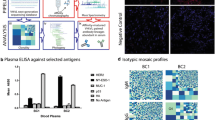Abstract
Intratumoral B lymphocytes are an integral part of the lung tumor microenvironment. Interrogation of the antibodies they express may improve our understanding of the host response to cancer and could be useful in elucidating novel molecular targets. We used two strategies to explore the repertoire of intratumoral B cell antibodies. First, we cloned VH and VL genes from single intratumoral B lymphocytes isolated from one lung tumor, expressed the genes as recombinant mAbs, and used the mAbs to identify the cognate tumor antigens. The Igs derived from intratumoral B cells demonstrated class switching, with a mean VH mutation frequency of 4 %. Although there was no evidence for clonal expansion, these data are consistent with antigen-driven somatic hypermutation. Individual recombinant antibodies were polyreactive, although one clone demonstrated preferential immunoreactivity with tropomyosin 4 (TPM4). We found that higher levels of TPM4 antibodies were more common in cancer patients, but measurement of TPM4 antibody levels was not a sensitive test for detecting cancer. Second, in an effort to focus our recombinant antibody expression efforts on those B cells that displayed evidence of clonal expansion driven by antigen stimulation, we performed deep sequencing of the Ig genes of B cells collected from seven different tumors. Deep sequencing demonstrated somatic hypermutation but no dominant clones. These strategies may be useful for the study of B cell antibody expression, although identification of a dominant clone and unique therapeutic targets may require extensive investigation.




Similar content being viewed by others
Abbreviations
- CDR:
-
Complementarity-determining region
- CT antigens:
-
Cancer-testis antigens
- GC:
-
Germinal center
- ITL:
-
Intratumoral lymphocyte
- MS:
-
Mass spectrometry
- NGS:
-
Next-generation sequencing
- NSCLC:
-
Non-small cell lung cancer
- PVDF:
-
Polyvinylidene fluoride
- ROC analysis:
-
Receiver-operating characteristic analysis
- TPM4:
-
Tropomyosin 4
- VH:
-
Variable heavy chain immunoglobulin domain
- VL:
-
Variable light chain immunoglobulin domain
References
Colotta F, Allavena P, Sica A, Garlanda C, Mantovani A (2009) Cancer-related inflammation, the seventh hallmark of cancer: links to genetic instability. Carcinogenesis 30:1073–1081
Heuvers ME, Aerts JG, Cornelissen R, Groen H, Hoogsteden HC, Hegmans JP (2012) Patient-tailored modulation of the immune system may revolutionize future lung cancer treatment. BMC Cancer 12:580
Gunderson AJ, Coussens LM (2013) B cells and their mediators as targets for therapy in solid tumors. Exp Cell Res 319:1644–1649. doi:10.1016/j.yexcr.2013.03.005
de Visser KE, Eichten A, Coussens LM (2006) Paradoxical roles of the immune system during cancer development. Nat Rev Cancer 6:24–37
Silina K, Rulle U, Kalnina Z, Line A (2014) Manipulation of tumour-infiltrating B cells and tertiary lymphoid structures: A novel anti-cancer treatment avenue? Cancer Immunol Immunother CII 63:643–662. doi:10.1007/s00262-014-1544-9
Andreu P, Johansson M, Affara NI et al (2010) FcRgamma activation regulates inflammation-associated squamous carcinogenesis. Cancer Cell 17:121–134. doi:10.1016/j.ccr.2009.12.019
Barbera-Guillem E, May KF Jr, Nyhus JK, Nelson MB (1999) Promotion of tumor invasion by cooperation of granulocytes and macrophages activated by anti-tumor antibodies. Neoplasia 1:453–460
de Visser KE, Korets LV, Coussens LM (2005) De novo carcinogenesis promoted by chronic inflammation is B lymphocyte dependent. Cancer Cell 7:411–423. doi:10.1016/j.ccr.2005.04.014
Tan TT, Coussens LM (2007) Humoral immunity, inflammation and cancer. Curr Opin Immunol 19:209–216
Al-Shibli KI, Donnem T, Al-Saad S, Persson M, Bremnes RM, Busund LT (2008) Prognostic effect of epithelial and stromal lymphocyte infiltration in non-small cell lung cancer. Clin Cancer Res 14:5220–5227
Riemann D, Wenzel K, Schulz T, Hofmann S, Neef H, Lautenschlager C, Langner J (1997) Phenotypic analysis of T lymphocytes isolated from non-small-cell lung cancer. Int Arch Allergy Immunol 114:38–45
Pelletier MP, Edwardes MD, Michel RP, Halwani F, Morin JE (2001) Prognostic markers in resectable non-small cell lung cancer: a multivariate analysis. Can J Surg 44:180–188
Mahmoud SM, Lee AH, Paish EC, Macmillan RD, Ellis IO, Green AR (2012) The prognostic significance of B lymphocytes in invasive carcinoma of the breast. Breast Cancer Res Treat 132:545–553
Schmidt M, Bohm D, von Torne C et al (2008) The humoral immune system has a key prognostic impact in node-negative breast cancer. Cancer Res 68:5405–5413
Hiraoka N, Ino Y, Yamazaki-Itoh R, Kanai Y, Kosuge T, Shimada K (2015) Intratumoral tertiary lymphoid organ is a favourable prognosticator in patients with pancreatic cancer. Br J Cancer 112:1782–1790. doi:10.1038/bjc.2015.145
Milne K, Kobel M, Kalloger SE, Barnes RO, Gao D, Gilks CB, Watson PH, Nelson BH (2009) Systematic analysis of immune infiltrates in high-grade serous ovarian cancer reveals CD20, FoxP3 and TIA-1 as positive prognostic factors. PLoS ONE 4:e6412
Zirakzadeh AA, Marits P, Sherif A, Winqvist O (2013) Multiplex B cell characterization in blood, lymph nodes, and tumors from patients with malignancies. J Immunol 190:5847–5855
Dieu-Nosjean MC, Antoine M, Danel C et al (2008) Long-term survival for patients with non-small-cell lung cancer with intratumoral lymphoid structures. J Clin Oncol 26:4410–4417
Gottlin EB, Bentley RC, Campa MJ, Pisetsky DS, Herndon JE 2nd, Patz EF Jr (2011) The association of intratumoral germinal centers with early-stage non-small cell lung cancer. J Thorac Oncol 6:1687–1690
Germain C, Gnjatic S, Tamzalit F et al (2014) Presence of B cells in tertiary lymphoid structures is associated with a protective immunity in patients with lung cancer. Am J Respir Crit Care Med 189:832–844. doi:10.1164/rccm.201309-1611OC
Coronella JA, Spier C, Welch M, Trevor KT, Stopeck AT, Villar H, Hersh EM (2002) Antigen-driven oligoclonal expansion of tumor-infiltrating B cells in infiltrating ductal carcinoma of the breast. J Immunol 169:1829–1836
Kotlan B, Simsa P, Foldi J, Fridman WH, Glassy M, McKnight M, Teillaud JL (2003) Immunoglobulin repertoire of B lymphocytes infiltrating breast medullary carcinoma. Hum Antibod 12:113–121
Kotlan B, Simsa P, Teillaud JL, Fridman WH, Toth J, McKnight M, Glassy MC (2005) Novel ganglioside antigen identified by B cells in human medullary breast carcinomas: the proof of principle concerning the tumor-infiltrating B lymphocytes. J Immunol 175:2278–2285
Nzula S, Going JJ, Stott DI (2003) Antigen-driven clonal proliferation, somatic hypermutation, and selection of B lymphocytes infiltrating human ductal breast carcinomas. Cancer Res 63:3275–3280
Pages F, Galon J, Dieu-Nosjean MC, Tartour E, Sautes-Fridman C, Fridman WH (2010) Immune infiltration in human tumors: a prognostic factor that should not be ignored. Oncogene 29:1093–1102
Willis SN, Mallozzi SS, Rodig SJ et al (2009) The microenvironment of germ cell tumors harbors a prominent antigen-driven humoral response. J Immunol 182:3310–3317
Dieu-Nosjean MC, Goc J, Giraldo NA, Sautes-Fridman C, Fridman WH (2014) Tertiary lymphoid structures in cancer and beyond. Trends Immunol 35:571–580. doi:10.1016/j.it.2014.09.006
Tiller T, Meffre E, Yurasov S, Tsuiji M, Nussenzweig MC, Wardemann H (2008) Efficient generation of monoclonal antibodies from single human B cells by single cell RT-PCR and expression vector cloning. J Immunol Methods 329:112–124. doi:10.1016/j.jim.2007.09.017
Liao HX, Levesque MC, Nagel A et al (2009) High-throughput isolation of immunoglobulin genes from single human B cells and expression as monoclonal antibodies. J Virol Methods 158:171–179. doi:10.1016/j.jviromet.2009.02.014
Liao HX, Chen X, Munshaw S et al (2011) Initial antibodies binding to HIV-1 gp41 in acutely infected subjects are polyreactive and highly mutated. J Exp Med 208:2237–2249. doi:10.1084/jem.20110363
Liao HX, Lynch R, Zhou T et al (2013) Co-evolution of a broadly neutralizing HIV-1 antibody and founder virus. Nature 496:469–476. doi:10.1038/nature12053
Kepler TB (2013) Reconstructing a B-cell clonal lineage. I. Statistical inference of unobserved ancestors. F1000Res 2:103. doi:10.12688/f1000research.2-103.v1 eCollection 2013
Kepler TB, Munshaw S, Wiehe K et al (2014) Reconstructing a B-Cell clonal lineage. II. Mutation, selection, and affinity maturation. Front Immunol 5:170. doi:10.3389/fimmu.2014.00170
Notkins AL (2004) Polyreactivity of antibody molecules. Trends Immunol 25:174–179
Mano H (2012) ALKoma: a cancer subtype with a shared target. Cancer Discov 2:495–502
Christensen JD, Colby TV, Patz EF Jr (2010) Correlation of [18F]-2-fluoro-deoxy-d-glucose positron emission tomography standard uptake values with the cellular composition of stage I nonsmall cell lung cancer. Cancer 116:4095–4102
Mantovani A, Garlanda C, Allavena P (2010) Molecular pathways and targets in cancer-related inflammation. Ann Med 42:161–170
DeNardo DG, Andreu P, Coussens LM (2010) Interactions between lymphocytes and myeloid cells regulate pro- versus anti-tumor immunity. Cancer Metastasis Rev 29:309–316. doi:10.1007/s10555-010-9223-6
MacLennan IC (1994) Germinal centers. Annu Rev Immunol 12:117–139
Chen Y (2004) Identification of human tumor antigens by serological expression cloning: an online review on SEREX. Cancer Immunity. http://www.cancerimmunity.org/serex. Accessed 2 Dec 2015
Punt CJ, Barbuto JA, Zhang H, Grimes WJ, Hatch KD, Hersh EM (1994) Anti-tumor antibody produced by human tumor-infiltrating and peripheral blood B lymphocytes. Cancer Immunol Immunother 38:225–232
Yasuda M, Takenoyama M, Obata Y, Sugaya M, So T, Hanagiri T, Sugio K, Yasumoto K (2002) Tumor-infiltrating B lymphocytes as a potential source of identifying tumor antigen in human lung cancer. Cancer Res 62:1751–1756
Volkheimer AD, Weinberg JB, Beasley BE, Whitesides JF, Gockerman JP, Moore JO, Kelsoe G, Goodman BK, Levesque MC (2007) Progressive immunoglobulin gene mutations in chronic lymphocytic leukemia: evidence for antigen-driven intraclonal diversification. Blood 109:1559–1567. doi:10.1182/blood-2006-05-020644
Morris L, Chen X, Alam M et al (2011) Isolation of a human anti-HIV gp41 membrane proximal region neutralizing antibody by antigen-specific single B cell sorting. PLoS ONE 6:e23532. doi:10.1371/journal.pone.0023532
Birring SS, Peake MD (2005) Symptoms and the early diagnosis of lung cancer. Thorax 60:268–269
Moody MA, Yates NL, Amos JD et al (2012) HIV-1 gp120 vaccine induces affinity maturation in both new and persistent antibody clonal lineages. J Virol 86:7496–7507
Moody MA, Zhang R, Walter EB et al (2011) H3N2 influenza infection elicits more cross-reactive and less clonally expanded anti-hemagglutinin antibodies than influenza vaccination. PLoS ONE 6:e25797
Chen ZJ, Wheeler CJ, Shi W, Wu AJ, Yarboro CH, Gallagher M, Notkins AL (1998) Polyreactive antigen-binding B cells are the predominant cell type in the newborn B cell repertoire. Eur J Immunol 28:989–994
Zhou ZH, Zhang Y, Hu YF, Wahl LM, Cisar JO, Notkins AL (2007) The broad antibacterial activity of the natural antibody repertoire is due to polyreactive antibodies. Cell Host Microbe 1:51–61
Gunning P, O’Neill G, Hardeman E (2008) Tropomyosin-based regulation of the actin cytoskeleton in time and space. Physiol Rev 88:1–35. doi:10.1152/physrev.00001.2007
Li DQ, Wang L, Fei F et al (2006) Identification of breast cancer metastasis-associated proteins in an isogenic tumor metastasis model using two-dimensional gel electrophoresis and liquid chromatography-ion trap-mass spectrometry. Proteomics 6:3352–3368. doi:10.1002/pmic.200500617
Lleo A, Invernizzi P, Gao B, Podda M, Gershwin ME (2010) Definition of human autoimmunity–autoantibodies versus autoimmune disease. Autoimmun Rev 9:A259–A266
Acknowledgments
We thank Thaddeus C. Gurley and Minyue Wang for expert technical assistance, and gratefully acknowledge the Duke Human Vaccine Institute Flow Cytometry Shared Resource Facility for the isolation of tumor B cells. This work was supported by Grants from the LUNGevity Foundation and the Department of Defense (W81XWH-13-1-0189) to Edward F. Patz, Jr.
Author information
Authors and Affiliations
Corresponding author
Ethics declarations
Conflict of interest
None of the authors of this paper have a conflict of interest.
Electronic supplementary material
Below is the link to the electronic supplementary material.
Rights and permissions
About this article
Cite this article
Campa, M.J., Moody, M.A., Zhang, R. et al. Interrogation of individual intratumoral B lymphocytes from lung cancer patients for molecular target discovery. Cancer Immunol Immunother 65, 171–180 (2016). https://doi.org/10.1007/s00262-015-1787-0
Received:
Accepted:
Published:
Issue Date:
DOI: https://doi.org/10.1007/s00262-015-1787-0




